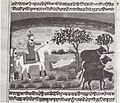This article has multiple issues. Please help improve it or discuss these issues on the talk page . (Learn how and when to remove these messages)
|
Rai Bular | |
|---|---|
 Posthumous depiction | |
| Born | Rai Bular Bhatti c. 1425 (according to records kept by bards) or 1430 |
| Died | c. 1515 or 1518 |
| Occupation(s) | Zamindar of Rai-Bhoi-Di-Talwandi, now Nankana Sahib |
| Employer | Daulat Khan |
| Known for | involvement in life of Guru Nanak |
| Father | Rai Bhoe |
Rai Bular Bhatti (died c. 1515 or 1518) [1] [2] was a Muslim Rajput feudal lord of the Bhatti clan during the latter half of the 15th century.



